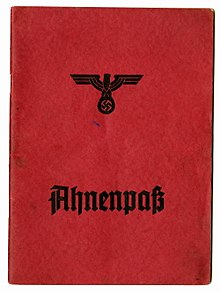Ancestral passport
The ancestral passport was a legal document of identification that contained officially certified proof of parentage. Proof of parentage consisted of dates of birth, death or marriage, which were confirmed by a registry office to match the relevant documents from a matriculation office , usually the parish registers of a parish office . The ancestral passport was issued by the “Reich Association of Registrars of Germany” since 1933 and was used exclusively for “ proof of Aryan descent ”, so it could not be used as a substitute in other cases in which documents had to be presented.
Emergence
prehistory
Proof of "Aryan descent" up to the grandparents was required under National Socialism by various laws ( Nuremberg Laws , Professional Civil Servants Act , later also the German Civil Servants Act ). For example, the “ Reich Citizenship Law ” - one of the two Nuremberg Laws - eliminated equality with the distinction between “Reich Citizens”, who were in full possession of all rights, and “Citizens” who did not have Reich citizenship and were given special rights the law. In order to enable the authorities to act on this basis , the ancestral passport was introduced in 1933, shortly after the so-called “ seizure of power ”.
background
The ancestral passport was based on the idea of belonging to a “people” based on genealogy instead of on the basis of cultural characteristics. Its inventors imagined a "German people" as a "blood community" and as a collective of people with innate common personality traits. In order to be able to separate the members of the “German national community” from the racially undesirable minorities such as Jews, Roma and Sinti within the population according to racist criteria and to be able to privilege some and segregate others, administrative instruments were required. One such instrument was the ancestral passport.
The German genealogists' associations, with the exception of the German Roland , did not take part in anti-Semitic efforts until 1932. However, that changed from 1933 when the state required proof of parentage.
It is true that the possession of an ancestral passport was not an obligation, but it was recommended to everyone - including non-“Aryans”. It was time-consuming to create it, because information was only recognized on the basis of original documents or certified copies. A complete ancestral passport, certified by the registry office and / or church, replaces the otherwise required proof of individual birth , baptism and marriage certificates.
content
It contained forms to certify the birth , baptism , marriage and death of the owner and his ancestors up to the fifth generation (great-great-great-grandparents, also: old-grandparents ) after submitting appropriate documents. The extent to which it had to be filled out in order to serve as evidence depended on the individual case; as a rule, complete evidence up to the generation of the great-grandparents was also considered sufficient at that time.
expenditure
Ancestral passports were published by the REICHSVERBAND DER REGISTER OFFICIALS OF GERMANY in the VERLAG FÜR STANDESAMTSWESEN and by the central publishing house of the NSDAP. The latter are adorned with the imperial eagle from 1935. The editions are not dated and differ among other things in the forewords.
Whereabouts
After submitting it to an authority or agency, the ancestral passport was handed over again. That means ancestral passports have not been archived. Only the pedigree certificates of members of the SS were retained by the Race and Settlement Main Office and archived in the Berlin Document Center after 1945 and are now in Department R of the Federal Archives in Berlin-Lichterfelde.
The German genealogy company Genealogy24 provides digital copies of ancestral passports and family records for the purpose of genealogical research as part of an online library . This collection is said to be the world's largest public collection of its kind.
literature
- The couple's ancestral passport. Publishing house for registry offices, Berlin 1939.
- Eric Ehrenreich: The Nazi Ancestral Proof: Genealogy, Racial Science, and the Final Solution. Bloomington, Indiana: Indiana University Press, 2007, ISBN 978-0-253-34945-3 .
- Cornelia Essner: The "Nuremberg Laws" or The Administration of Rassenwahns 1933–1945. Schöningh, Paderborn 2002, ISBN 3-506-72260-3 .
- Volkmar Weiss : The prehistory of the Aryan ancestral pass. In: Genealogy , Vol. 50 (2001) pp. 417-436, 497-507 and 615-627.
Web links
Single receipts
- ↑ Historical or national genealogy. Family history or clan research? In: Prehistory and consequences of the Aryan ancestral pass: On the history of genealogy in the 20th century. Arnshaugk, Neustadt an der Orla, 2013, ISBN 978-3-944064-11-6 , pp. 48-66.
- ↑ The seizure of power by the ranchers . In: Prehistory and consequences of the Aryan ancestral pass: On the history of genealogy in the 20th century. Arnshaugk, Neustadt an der Orla 2013, pp. 66–90.
- ↑ Ancestral Passes website - http://www.dilibra.com , accessed December 6, 2014.



